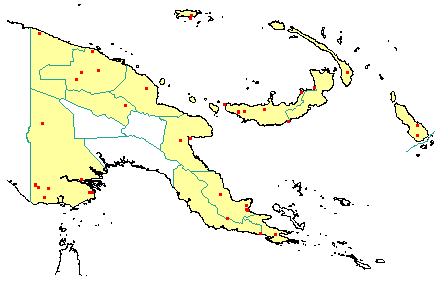
in PNGplants database
PNGTreesKey – Aceratium oppositifolium DC. |
Barry Conn (NSW) & Kipiro Damas (LAE).
Guide to trees of Papua New Guinea
Copyright held by the authors, National Herbarium of New South Wales, and Papua New Guinea National Herbarium
Prodromus Systematis Naturalis Regni Vegetabilis, Sive Enumeratio Contracta Ordinum Generum Specierumque Plantarum Huc Usque Cognitarum, Juxta Methodi Naturalis Normas Digesta Vol. 1: 519 (1824)
Other Literature: M.J.E. Coode, Handbooks of the Flora of Papua New Guinea Vol. 2: 45-46 (1981) Fig. 13.
Family: Elaeocarpaceae
Dicotyledon
Timber Group: Non-timber species
Field Characters: Small sub-canopy tree (up to 10 m high); Bole cylindrical (mostly less than 30 cm diam.); straight (bole usually short, 2-3 m long, trunk often branching from near base and forming a large shrub or small treelet); buttresses buttresses absent; spines spines absent; aerial roots aerial roots absent; stilt roots sometimes stilt roots present or stilt roots absent; Bark white, pale yellow, pale grey, or brown (mottled), smooth; Subrhytidome (under-bark) green; less than 25 mm thick; bark blaze consisting of one layer; faintly to non-aromatic; outer blaze white, yellow (pale straw-coloured), or pale brown, markings absent; inner blaze white, yellow (pale straw-coloured), or pale brown, markings absent; bark exudate (sap) absent; terminal buds not enclosed by leaves.
Indumentum: Complex hairs absent; stinging hairs absent; mature twig indumentum (hairs) present when young or later absent, hairs dense to sparse.
Leaves: Leaves spaced along branches, opposite (in pairs, opposite one another on the branchlet), simple (a leaf composed of a single blade); petiole present, not winged, attached to base of leaf blade, not swollen; leaves sometimes broadest above middle, broadest at or near middle, or sometimes broadest below middle, 5.0-11.0 cm, 2.0-4.0 (-6.0) cm; symmetric, entire to serrate to dentate (toothed), not dissected or lobed, acute or often acuminate, venation pinnate, secondary veins open, prominent, intramarginal veins absent; leaves lower surface dark green, green (often silvery), or brown (with brown hairs), upper surface often dark green, green, brown, or red (slightly with brown hairs), indumentum (hairs) present, indumentum (hairs) dense to sparse; absent; domatia absent; stipules absent.
Flowers: Inflorescence axillary, flowers on an unbranched axis, cones absent; flowers bisexual, stalked, flowers with many planes of symmetry, (9.0-) 13.0-16.0 (-20.0) mm long, diameter small (up to10 mm diam.); perianth present, with distinct sepals and petals whorls, inner perianth white to yellow (pale cream-coloured) or slightly pink or slightly red; 5, free; stamens 5, present, free of each other, free of the perianth; ovary superior, carpels joined (when more than one), locules 3-4; styles solitary, 1.
Fruits: Infrutescence arranged on unbranched axis, fruit 30.0-35.0 mm long, red, not spiny, fleshy, simple, indehiscent, drupe; seeds 1, about 10 mm long, not winged, narrow (longer than wide), seed 1-10 mm diam.
Distribution: West Sepik, East Sepik, Madang, Morobe, Western Highlands, Western, Central, Northern, Milne Bay, New Britain, New Ireland, Manus & Bougainville.
 | Botanical records in PNGplants database |